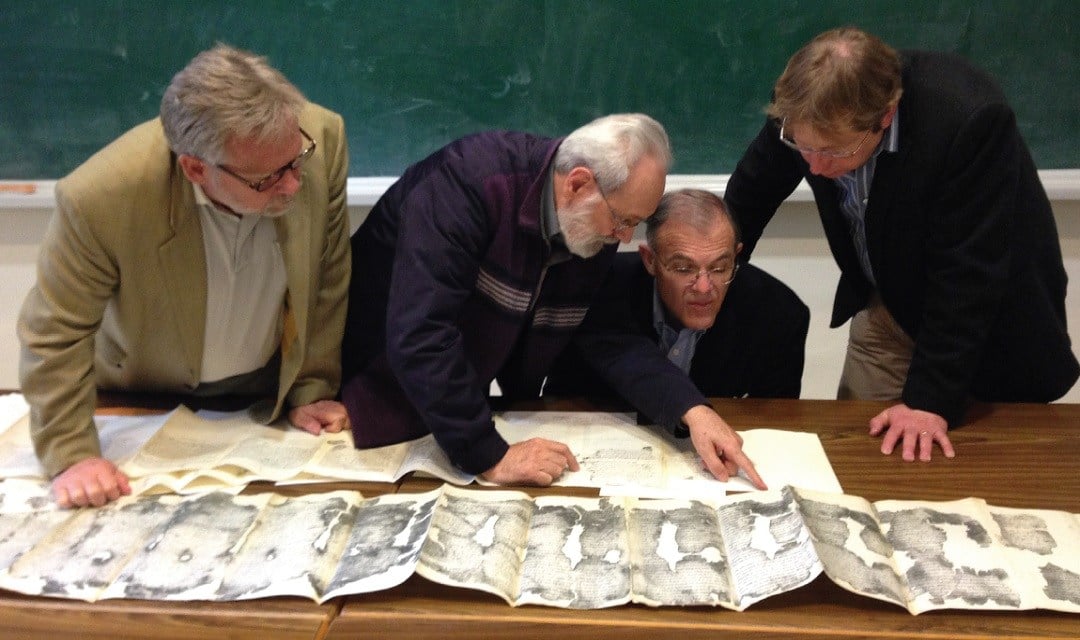This article first appeared in the CHRISTIAN RESEARCH JOURNAL, volume 36, number 05 (2013). The full text of this article in PDF format can be obtained by clicking here. For further information or to subscribe to the CHRISTIAN RESEARCH JOURNAL go to: http://www.equip.org/christian-research-journal/
At the premiere for The Bible TV series in New York City, the crowd was as mesmerized with the Dead Sea Scrolls and early biblical manuscripts as with the assortment of celebrity onlookers.1 When famed producer Mark Burnett spoke before the crowd and cameras, he highlighted the biblical artifacts from the Green Collection as much as the blockbuster series he and Roma Downey had just produced. He emphasized that these ancient biblical texts helped validate the Old and New Testament stories they had captured on film. These magnetic producers leaned into the cameras and championed not only a captivating narrative but its historical validity.2
Those artifacts were only a glimpse of the Green Collection’s trove of supporting evidence for the Bible. A few days earlier, Hank Hanegraaff had interviewed me on air about the Green Collection, numbering more than 40,000 biblical artifacts and growing. He prompted the question anew: “How do we know what is true?”3
The Codex Climaci Rescriptus was among the texts presented at the Bible Series premiere in New York. The Syriac was written over a couple layers of texts. The Rescriptus (or reused text) is among the earliest Bibles known, and among the earliest associated with Jesus’ language and dialect (ca. fifth century AD). The project is housed at Tyndale House, Cambridge, led by Dr. Peter Williams. His team is able to read the lower layers of text using multispectral imaging.
RELIABILITY
Hank’s question is indeed a priori. So how do we know what is true? When we read about important events and discoveries, especially in this high-tech age of knowledge overdose, how do we know the stories weren’t manufactured? In 1517, did Martin Luther really nail his “95 theses” to the Wittenberg door? Did Joseph Smith really hear from a talking salamander? Can we confidently state that Jesus lived in Galilee and died in Jerusalem in the first century?
Without empirical evidence, some people simply will not believe parts of the Bible story, or any stories. Neither will they use a text or an artifact unless concrete evidence supports its authenticity.
Two questions dominate our world of ancient manuscripts and texts. “What is authentic?” and “What is accurate?” And a third question is also asked individually by religious people: “What has authority in my life?” While the latter question is a matter of one’s faith, the first two are matters of scientific inquiry.
In order to determine what is indeed fact—true in the historical record—historians first ascertain whether the source of the information is trustworthy. Is it historically reliable? Scientists quickly determined that the Salamander Letter was a forgery, made by a Mormon businessman to fool fellow Mormons and profit around $1 million. We can safely conclude that Joseph Smith never held a conversation with a salamander.4 What’s important for our study of historical sources, especially biblical material, is acknowledging and welcoming the use of recognized tests to determine source credibility.5
Historical reliability depends on both authenticity of sources and their accuracy. Is an ancient text, for example, actually from the stated time period of its origin—or is it a reliable copy based on an accurate version from that period? Both cases are valuable. Does the source accurately describe or represent events in question? Something may indeed be ancient, but other sources reveal its contents’ inconsistencies (common in royal propaganda).
These “primary” sources surface in many places. For example, you can see in the Green Collection some of the Dead Sea Scrolls or P39 (Papyrus 39, a third-century Greek copy of Romans 8:14–22). Or, you can go to the Institut für Neutestamentliche Textforschung in Münster, Germany, and study the images of most of the actual early manuscripts behind each verse in your New Testament (including P39), the same reservoir that has backed twenty-eight editions of the Nestle-Aland Greek New Testament. The institute has released these virtual resources on their free website, commonly called the VMR (see: www.uni-muenster.de/INTF.); from your laptop you’re able to view images of the primary sources underpinning your New Testament.
The corroboration of evidence helps to determine truthfulness. Numerous types of evidence usually exist for any historical event, diagramed by Edwin Yamauchi below, such as literature, personal records, archeology, testimonials, laws, tradition, and geography. Let us now concede that not only can we ascertain whether most sources are authentic, but whether they demonstrate a strong possibility of being trustworthy. In historical studies, we work toward the highest probability, or inference to the best explanation.
NEW TECHNOLOGY FOR BIBLICAL RESEARCH
In the case of the Salamander Letter, the ink on the forgery hadn’t aged properly. Indeed, inks are extremely important in text studies. For New Testament and many medieval texts, carbon-based inks manifest themselves differently over time than later inks. And even reproducing more recent forms of ink creates “traces” that give away its age.
In April of 2013, I presented at a workshop at the Israel Museum to a select group of scientists, conservators, and curators. We discussed not only the textual markers for authenticity, such as paleography, historical corroboration, and textual comparisons, but also a battery of tests on the material items themselves produce considerable empirical evidence. From consistent hair follicle patterns on parchment to the ancient saline levels and DNA tests on animals (for making the parchment leaves or scrolls) we have multiple data points. One scholar identified the various types of animals used to make each Dead Sea Scroll, and the likely place of origin of those animals in antiquity (in the general area of Israel).6
The main centers of this research besides Hebrew University are the University of Southern California under the auspices of Dr. Bruce Zuckerman, and near UCLA at the Early Manuscripts Electronic Library (EMEL), directed by Dr. Michael Phelps (former director of Claremont’s Ancient Manuscript Center). Zuckerman (another former director of the AMC) utilizes Reflective Transformation Imaging (RTI) research and can magnify ancient texts and seals with such clarity that once invisible letters and under texts (written over) are visible for the first time. Many of the Dead Sea Scrolls and Akkadian texts on cuneiform are unreadable without such help.7
Twenty years ago, our colleagues (e.g. Dr. Gordon Young from Purdue) had to use a special ammonia compound to read clay tablets in the Van Kampen Collection. It emitted a white vapor that could be blown across the tablets creating stark contrasts on the wedge-shaped symbols, and thus better photographs were produced. Today, Zuckerman’s RTI machines can capture better images through dozens of light points and color manipulation.8
The Multiple Spectral Imaging that Michael Phelps utilizes can read an item’s chemical properties. It can draw contrasts and readings that amplify our knowledge of the scroll, manuscript, or artifact. Another test adjusts contrast intensity, and texts either clarify or disappear depending on the ink’s composition or other chemical contrasts in the material.
CORROBORATION OF AUTHENTIC AND ACCURATE SOURCES
Numerous primary sources attest to the truthfulness of events, such as Jesus’ actions. Using standard scientific and historiographical inquiry, we are reasonably certain about the historical reliability of many aspects of the biblical narrative.
The life of Jesus of Nazareth is attested by early copies of firsthand accounts, the support for our New Testament books. The Green Collection is adding to this growing corpus of early textual evidence, and the findings will begin surfacing in 2014 in our series with Brill Publishing (Leiden).
Most days of Christ’s life are not recorded—but we have enough information from various spheres of evidence to call the biblical accounts truthful and historical, and to under- stand the essence of His significance in history. In “The Jesus of History: Corroboration of Evidence,” Dr. Edwin Yamauchi makes an engaging and sustainable argument for the historicity of Christ—even if the New Testament didn’t exist.
Long before the new technology, scholars have pored over evidence and have already amassed quite a case for the Bible’s reliability. Using what we now consider rather outdated technology, Emile Puech had some rather convincing results in his Dead Sea Scroll research. On April 12, 2013, Emile Puech showed me how he reconstructed an actual scroll from 1970s photos of thousands of Dead Sea Scroll fragments at the École Biblique, Jerusalem.
We have seen here the multifaceted steps being taken to understand the texts’ reliability, and that the same rules of discovery and assessment apply to the biblical research as to other historical events. While ultimately the Bible’s authority in our lives is a personal decision, the validity of the text is professionally substantiated. Questions persist, but the positive answers are many, and ever increasing.
Jerry Pattengale, Ph.D., is the executive director of the Green Scholars Initiative. He also serves as the assistant provost at Indiana Wesleyan University and holds distinguished positions at Tyndale House-Cambridge, Baylor University, Gordon-Conwell Theological Seminary, and the Sagamore Institute. He is the associate publisher for The Christian Scholar’s Review and contributes regularly to Books and Culture.
NOTES
- March 19, 2013; see Stoyan Zaimon, “The Bible Experience: Exclusive Rare Artifacts Presented by Mark Burnett and Roma Downey,” The Christian Post (March 20, 2013).
- See Jerry Pattengale, Biblical Evidence: Logical Approaches to Objectivity (Triangle, 2012).
- March 11, 2013; see www.equip.org. The Green Collection is named after David Green and his family, the owners of Hobby Lobby and the funders for the Green Scholars Initiative. Along with the Green Collection, which began in 2010, and in addition to supporting traveling exhibits (see www.explorepassages.com) in the United States and abroad, they will be the main supporters of the new national Bible museum in Washington, D.C., in late 2017 (401 D Street SW [currently the Design Center]) near the U.S. Capitol. The research arm for the Green Collection is the Green Scholars Initiative (GSI): www.greenschol- arsinitiative.com.
- See Linda Sillitoe and Allen Roberts, Salamander: The Story of the Mormon Forgery Murders; Steven Naifeh and Gregory White Smith, The Mormon Murders: A True Story of Greed, Forgery, Deceit, and Death. See also Roger D. Launis’s review of Salamander in the John Whitmer Historical Association Journal 8 (1988): 79–82.
- On forgeries, see Martin Heide, “The Moabitica and Their Aftermath: How to Handle a Forgery Affair with an International Impact,” Society of Biblical Literature, ed. Tammi Schneider, New Inscriptions and Seals Related to the Biblical World (no. 19): 193–241. Dr. Heide helped to identify more than one thousand fake ostraca already in collections.
- See Gila Kachila Bar-Gal, “Implications of DNA to the Study of Ancient Parchment,” Workshop on the Long-term Preservation of Ancient Parchment and Papyri, Israel Museum (April 10, 2013).
- Zuckerman is director of the Archaeology Research Center at the University of Southern California, and director of West Semitic Research and InscriptiFact Projects (http://www.usc.edu/dept/LAS/wsrp/); Michael Phelps is the scholar imaging the texts at Mt. Sinai in St. Catherine’s Monastery (www.emelibrary.org).
- The Van Kampen Collection was the basis of the Scriptorium: Center for Christian Antiquities, which I codirected. The wonderful collection is now in Orlando.
THE JESUS OF HISTORY: CORROBORATION OF EVIDENCE
Dr. Edwin Yamauchi (emeritus professor, Miami University) notes that even without consulting the New Testament information about Jesus, the other written sources from His era confirm the following: “(1) Jesus was a Jewish teacher; (2) many people believed that he performed healings and exorcisms; (3) he was rejected by the Jewish leaders; (4) he was crucified under Pontius Pilate in the reign of Tiberius; (5) despite his shameful death, his followers, who believed that he was still alive, spread beyond Palestine so that there were multitudes of them in Rome by A.D. 64; (6) all kinds of people from the cities and countryside—men and women, slave and free—worshipped him as God by the beginning of the second century.”
Source: Edwin M. Yamauchi, “Jesus Outside the New Testament: What Is the Evidence?” Jesus Under Fire (Grand Rapids: Zondervan, 1995), 221–22; see 207–29.









